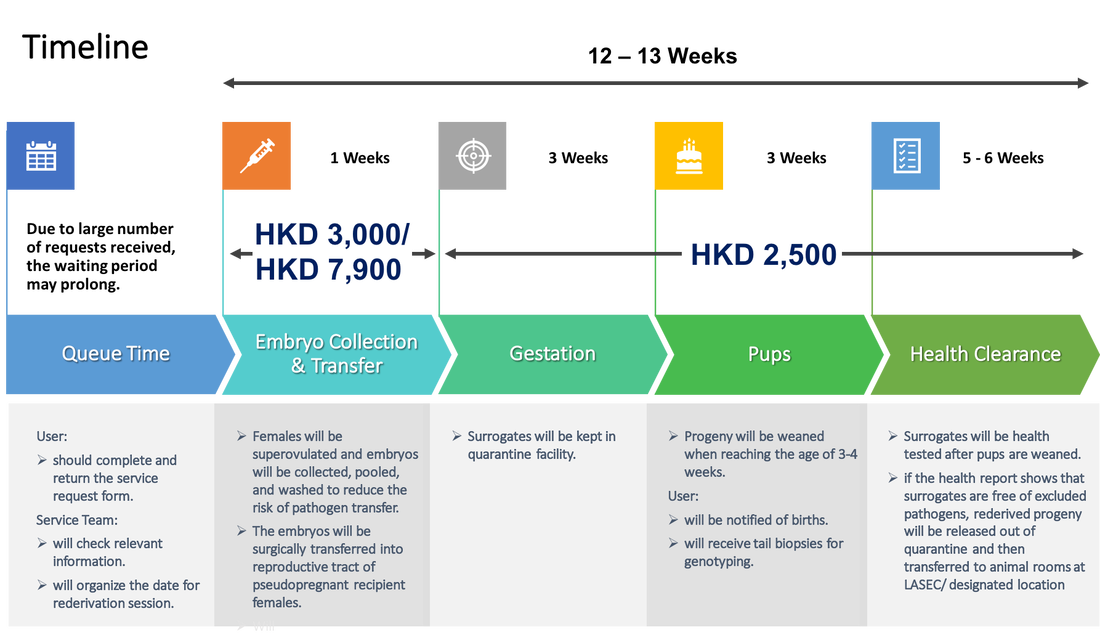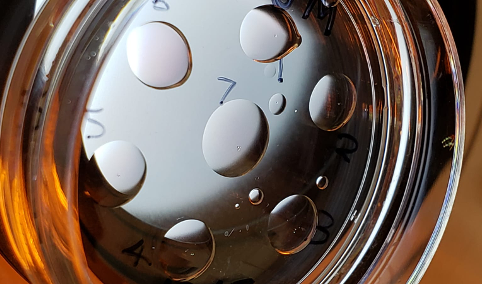Rederivation of Pathogen Infected Mouse line
For heterozygous lines:
- Investigator will provide 2 males at age of 10-24 weeks
- We will provide wild-type females from the appropriate genetic background (up to 12 females)
Pricing
|
Rederivation from fresh sperms with in vitro fertilization (IVF): HKD 7,900 per session**
Remarks: ** Charges for quarantine, heath screen, per diems, animal/ tissue transport, and cryo storage are NOT included. It includes the cost of wild-type females from the appropriate genetic background (up to 12 females). |
Each session comprises one session of IVF and embryo transfer, including:
- superovulation of donor females at ages of 21-28 days (8 - 12 females at common genetic backgrounds, such as C57BL/6);
- harvesting oocytes from donor females;
- harvesting fresh sperms from the epididymis of male mice at age of 10-24 weeks, or thawing one aliquot of cryopreserved sperm;
- performing IVF;
- harvesting and washing the resulting embryos in accordance with guidelines promulgated by the International Embryo Technology Society (IETS) to eliminate the pathogens;
- preparation of pseudopregnant females for embryo transfer; and
- transfer of all the resulting embryos into pseudopregnant recipients (Up to 4 pseudopregnant females).
For homozygous lines:
For homozygous lines:
- Investigator will provide 6-10 homozygous males at age of 10-24 weeks and equal number of homozygous females at age of 4-5 weeks or 8-12 weeks.
Pricing
Rederivation from fresh embryos: HKD 3,000 per session**
Remarks:
** Charges for animals, quarantine, heath screen, per diems, and animal/ tissue transport are NOT included. If the animals are housed outside CUHK, we may NOT be able to perform certain procedures, such as superovulation induction, mating setup, and tissue harvest.
Remarks:
** Charges for animals, quarantine, heath screen, per diems, and animal/ tissue transport are NOT included. If the animals are housed outside CUHK, we may NOT be able to perform certain procedures, such as superovulation induction, mating setup, and tissue harvest.
Each session includes:
- superovulation of donor females (Up to 12 females);
- setting up cross and checking plugs;
- harvesting preimplantation embryos;
- washing the embryos in accordance with guidelines promulgated by the International Embryo Technology Society (IETS) to eliminate the pathogens;
- preparation of pseudopregnant females; and
- transfer of all the embryos into psuedopregnant recipients (Up to 2 psuedopregnant females).
Useful information
- The number of embryos harvested from each mated female is highly variable between strains, genetic backgrounds, and individual mice (Stud males: mating performance; Donor females: productivity of embryos).
- The background strain of the mice for rederivation plays an important role in the success of the procedure. We may not be able to perform some procedures in certain strains of mice. Therefore, this information is critical for us to determine the potential success of your project.
- Based on our experience, one should estimate that 24 - 75% of transferred viable embryos will produce live offspring.
- Due to the cost of pseudopregnant animals and labor, every rederivation attempt is counted as a session.
- We do not guarantee that transfer of viable embryos will result in live births.
- Investigators should create a back‐up of their line, such as keeping one breeding cage as there is never 100% guarantee in the rederivation process.
- The number of sessions required could be decided by the user.
- PCR genotyping is available upon request at additional cost.
- A valid AEEC number must be provided prior to commencement of service.
- Completed service request form should be returned to us prior to commencement of service.
Quarantine
Pricing
Quarantine Service: HKD 2,500 per rederivation session
Each session includes:
- IVC housing for pseudopregnant females receiving embryo transfer and their offspring within the first 11 weeks in our quarantine facility;
- collection of tail biopsy from the pups when reaching 3 weeks of age for genotyping verification;
- delivery of tail biopsies to designated facility/ location for pick up by the investigator’s team; and
- health screen (Full panel).
Useful information
- The surrogates will be health tested after pups are weaned.
- Rederived progeny are usually released out of quarantine ~8-9 weeks and then transferred to animal rooms at LASEC/ designated location if the health report shows that surrogates are free of excluded pathogens.


